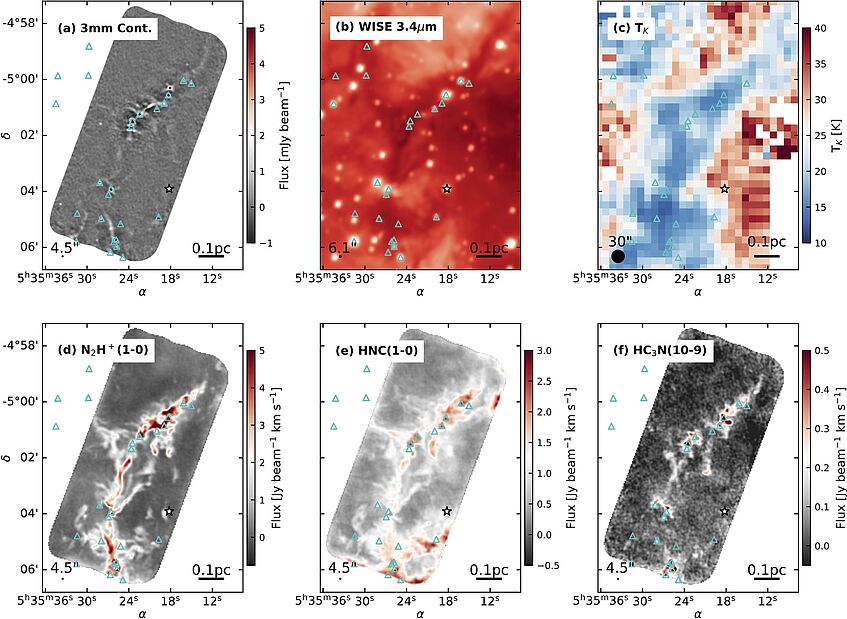EMERGE Early ALMA Survey
In the EMERGE Early ALMA Survey we investigated 7 star-forming regions in Orion (OMC-1/2/3/4 South, LDN 1641N, NGC 2023, and Flame Nebula) homogeneously surveyed in both molecular lines (N2H+ J=1-0, HNC J=1-0, plus HC3N J=10-9) and 3mm-continuum using a combination of interferometric ALMA mosaics and IRAM-30m single-dish (SD) maps together with a series of Herschel, Spitzer, and WISE archival data.

OMC-3 region observed as part of the EMERGE Early ALMA Survey
Paper I: Early ALMA Survey: observations and massive data reduction
In Hacar et al 2024 (Paper I), and in addition to the data processing, we investigated the global properties the 7 star-forming regions explored as part of the EMERGE Early ALMA Survey. We obtained independent continuum maps and spectral cubes for all our targets and molecular lines at different (SD and interferometric) resolutions and exploring multiple data combination techniques. Based on our low-resolution (SD) observations (30′′ or ∼ 12 000 au), we describe the global properties of our sample covering a wide range of physical conditions including low- (OMC-4 South, NGC 2023), intermediate (OMC-2, OMC-3, LDN 1641N), and high-mass (OMC-1, Flame Nebula) star-forming regions in different evolutionary stages. The comparison between our SD maps and ancillary YSO catalogs denotes N2H+ (1-0) as the best proxy for the dense, star-forming gas in our targets showing a constant star formation efficiency and a fast time evolution of ≲< 1 Myr. While apparently clumpy and filamentary in our SD data, all targets show a much more complex fibrous sub-structure at the enhanced resolution of our combined ALMA+IRAM-30m maps (4.5 or - 2 000 au). A large number of filamentary features at sub-parsec scales are clearly recognized in the high-density gas (> 105 cm−3) traced by N2H+ (1-0) directly connected to the formation of individual protostars. Surprisingly, this complex gas organization appears to extend further into the more diffuse gas (~103 - 104 cm−3) traced by HNC (1-0).
Paper II: The need for data combination in ALMA observations
In Bonanomi et al (2024) (Paper II) we explore the effects of the short-spacing information on state-of-the-art ALMA observations of the ISM structure. Using a series of idealized simulations cores and filaments we demonstrate the severe filtering effects produced in interferometric-only observations affecting the recovery of all physical properties (i.e. column density, mass, and size) in scientific images of resolved targets. These results have severe consequences for ALMA 12m-alone and 12m+7m data. Only the addition of the short-spacing information via TP data or, preferably, with a large single-dish telescope (e.g., IRAM-30m or AtLAST) allows to recover the true sky emission in interferometric observations. Our results demonstrate the need for the use of data combination techniques to accurately characterize the complex physical structure of the ISM in the ALMA era.
Paper III: Fiber networks in Orion
In a new paper of this series, Socci et al 2024a (Paper III), we have explored the gas organization of the 7 star-forming regions part of the EMERGE Early ALMA survey, namely OMC-1, 2, 3, 4 South, LDN1641N, Flame Nebula, and NGC2023. From the kinematic analysis our new N2H+ ALMA+IRAM30m observations we identified and characterised a total of 152 velocity-coherent fibers in our survey, which appear to be the preferred organisational unit for the dense gas in low-, intermediate- and high-mass star-forming regions alike. Despite the uneven density of fibers within these sub-parsec networks, the masses and lengths of these objects show similar distributions and consistent median values, as well as (trans-)sonic motions, in all of our targets. In other words, fibers are everywhere!
Paper IV: Environmental variation of the fiber widths
In our new paper Socci et al (2024b) (Paper IV) we demonstrate how fibers adapt their widths to their environment. We have studied the radial profiles of 152 fibers identified in 7 star-forming regions (see Paper III) part of the EMERGE Early ALMA survey (Paper I). We characterized the column density and temperature profiles of these targets and extract fundamental parameters such as the fiber width (FWHM), peak column density (N0), and temperature gradient. Most fibers show complex and non-isothermal profiles in all environments. More important, our results show a systematic variation of the fiber widths per region. Both within our sample and when compared to other surveys, our fibers show a systematic FWHM-N0 anti-correlation in agreement to previous theoretical predictions. This is the first observational evidence for a systematic variation of the fiber FWHM.
Coming soon!
Paper V is around the corner. Please stay tuned!
Data Products
- Access to DR1 in Dataverse (link)
